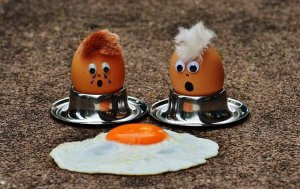We bought a nice big pot and sowed some parsley seeds in it. After some days it sprouted and a very strange thing happened. I guess pigeons love tender parsley leaves. Two pigeons just keep sitting inside those young seedlings and keep on pecking the leaves, as if they are enjoying a great feast. Even little pigeons are aware of healthy eating.
Well, coming back to our topic, if you want to loose weight by controlling your blood sugar then GI diet has got all the answers for your question. Glycemic Index diet was developed by Professor David Jenkins. It was made easier and turned into a famous series of diet books by Rick Gallop. The famous author sets the diet with traffic lights as example. Low GI foods are coloured green and you can eat it till your heart’s content. You can use the yellow coloured foods occasionally. While it is a big no-no for red coloured foods.
The diet can be explained as follows: the glycemic index is marked from 0 to 100. Glucose is the key component here and is set to 100 and all the other foods are compared with it.There are three categories in the GI diet the low, medium and high. Foods that have a GI value of 55 or less belong with the low category or in other words are very healthy. Foods that have a GI value of 56 to 69 belong with the medium category and foods that have a GI value of 70 or more fall into the high category. These are the foods that must me avoided. If you want to find out the GI value of foods here is the link to a health calculator
Foods that have a high GI value are easily digested and they increase the blood glucose levels rapidly. In this case you tend to snack on foods which results in weight gain. Foods which fall under the low category tends to get digested very slowly giving you a feeling of fullness. You do not feel like snacking in between meals and this greatly helps in weight management. Foods with low GI value maintain blood glucose levels at a constant state.
This diet is very useful for diabetes management. In fact many doctors and nutritionists recommend this diet for diabetic patients. This diet improves good cholesterol, reduces the risk of heart disease and helps you to slim down. Just to give you a base idea of what it is all about. Foods such as whole grains, protein, raw starches, legumes, vegetables, fruits and dairy products have low glycemic index.
Foods that contain high glycemic index are white breads, pasta, snack items such as potato chips and alcohol. To be on the healthier version of foods focus on oats, barley and choose breads with whole grain, stone ground flour for breakfast. Reduce your intake of white potatoes, eat plenty of vegetables and fruits and reduce the intake of rice, pasta and noodles. Eat lots of legumes such as beans, chick peas or lentils these are even good for your heart. There is good news for all people fond of rice. Researchers after analyzing 235 varieties of rice found out certain rice varieties such as swarna has a low GI index and Doongara and Basmati have a medium GI value.
The GI value talks about how rapidly a particular carbohydrate turns into sugar. Now it is important for us to know how much of that carbohydrate is in a serving. Now here is where the GL value comes into play. The glycemic load determines the effect of carbohydrate consumption using the glycemic index. It also accounts the amount of carbohydrate consumed.
Glycemic load can be calculated for a single serving or for food consumed the whole day. For one serving of food the GL which is greater than 20 is considered high, glycemic load value between 11to 19 is considered medium and a GL of ten or less is considered low. Foods that have low GL value are considered healthy. Here is a link to find out GL value of different food stuffs
It is now time to turn a new leaf in your life and start making healthy food choices to lead a more fulfilling and energetic life.
Take care,
Swarnam
Photo of fruit salad by Chainat
Photo courtesy of www.FreeDigitalPhotos.net
Take care,
Swarnam
Swarnam













